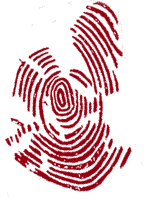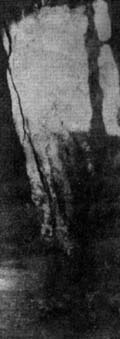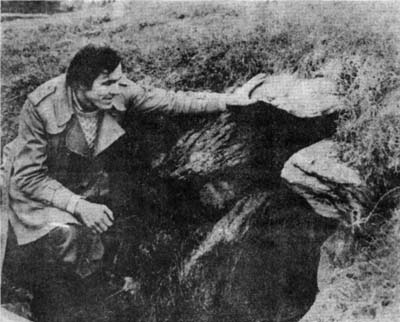 |
||
 About Stonelight 
The rays of the sun shining in to the chamber at sunset. |
December's sun solves stone mounds mystery.
By Christine Newman for The Irish Press, December 15th 1980 
Martin Brennan at the entrance to the Dowth mound in the Boyne Valley. A discovery has been made this weekend at the famous mounds of the Boyne Valley which will have international significance and mean far reaching changes in existing historical and archaeological theories about the world during and since Neolithic (Stone Age) times. The three mounds of Newgrange, Knowth and Dowth, have become famous partly because of the phenomenon of the rising sun projecting its rays into the recesses of the inner chamber of the Newgrange mound for about half an hour on the shortest day of the year, December 21. Now it has been discovered that when the sun sets on that day, the rays will enter the chamber of Dowth mound for about half an hour. Yesterday, the first day in the seven-day period leading up to December 21, the rays began to enter the chamber at sunset. By December 21, they will be shining directly into the chamber at sunset. The man who discovered this new fact is Martin Brennan, a researcher, who said that this had dispelled beyond a doubt any theory that the sun filling the Newgrange chamber on December 21 was accidental and means that what was in fact constructed was a highly sophisticated system of time-recording older than anything else ever discovered in the world. It also helps to dispel theories, he said, that the earth had shifted on its axis over the centuries as the alignment happens at the same time and the sun shines exactly on a single square stone with sun symbols engraved upon it in the Dowth chamber. A new Yorker, Martin Brennan has been working at the site all year in preparation for his book The Stars and the Stones. He has already written another book The Boyne Valley Vision. Over the weekend, he and his co-researcher, Jack Roberts, who are specialists in rock engravings, discovered that the sun was shining into the chamber and will build up to lighting up the entire stone on December 21. "The discovery takes a step beyond archaeology", he said. "Everybody missed it". "The discovery confirms that the astronomical alignments were preconceived and intentional. It demonstrates that early man directed attention towards the sun and moon and developed methods for making accurate precision observations that would enable formulating an efficient calendar," he said. "The fact that the rising sun enters Newgrange is astounding, however, the discovery that there are two mounds simultaneously aligned to both the sunrise and sunset of the shortest day of the year suggests that the scheme is much larger than what has previously been considered and much more sophisticated," Martin Brennan explained. The discovery suggested that the third larger mound, Knowth, was in fact, aligned to the equinox and the three mounds operated in a gigantic astronomical scheme, he said. The sunbeam, solar imagery, which was synchronised between the two mounds, was not the work of a primitive people. "The beginnings of civilisation had already started in the Neolithic Age, commonly known as the Stone Age," he said. There is no comparative evidence of any other sophisticated calendar as early as this before anywhere else in the world. Other recorded systems are at least 1,000 years later". The mounds date back to 3,500 B.C. and Martin Brennan described the site and the discovery as "larger, better, older than anything else." The discovery demanded changes in the text-books, he added. "The mounds are intact and still functioning. What we have preserved Stone Age schemes, it is astounding," he commented. The discovery, which will have international importance, will not only have significance for archaeologists. Anthropologists, astronomers and other, scientists will also be interested in the sensational discovery. It is expected that next Sunday, the experts will be down in the Boyne Valley, to witness for themselves the discovery which could lead to major reassessment of some of the history of civilisation. December 1980. |
Boyne Valley Private Day Tour Immerse yourself in the rich heritage and culture of the Boyne Valley with our full-day private tours.
Visit Newgrange World Heritage site, explore the Hill of Slane, where Saint Patrick famously lit the Paschal fire.
Discover the Hill of Tara, the ancient seat of power for the High Kings of Ireland.
Book Now
Immerse yourself in the rich heritage and culture of the Boyne Valley with our full-day private tours.
Visit Newgrange World Heritage site, explore the Hill of Slane, where Saint Patrick famously lit the Paschal fire.
Discover the Hill of Tara, the ancient seat of power for the High Kings of Ireland.
Book Now
|
